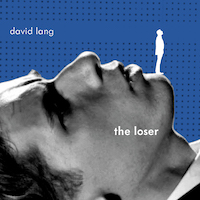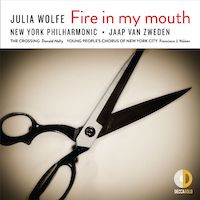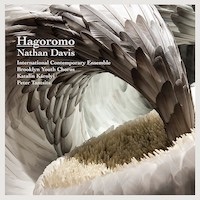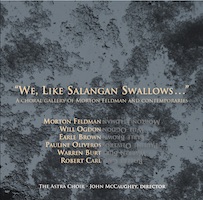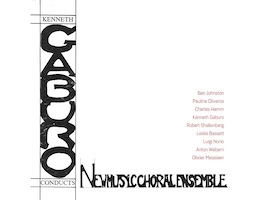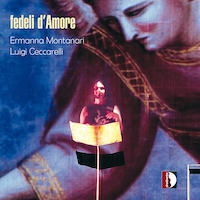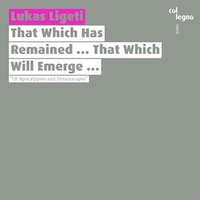Armchair Operas (and Voices) 15.
|
Grant Chu Covell [April 2021.]
David LANG: The Loser (2016). Rod Gilfry (bar), Conrad Tao (pno), Bang on a Can Opera Ensemble: Isabel Hagen (vla), Mariel Roberts (vlc), Pat Swoboda (cbs), Owen Weaver (perc), Lesley Leighton (cond.). Cantaloupe CA21155 (1 CD) (www.cantaloupemusic.com). This opera is not about Glenn Gould. Even though Gould appears (and Horowitz does too), this opera is about creativity and achievement, or mediocrity and failure depending upon your perspective. Two pianists encounter Gould at a master class and realize they will never be as great. One eventually commits suicide, the other is the opera’s narrator, sharing the effect Gould had on both their lives. I found this far more interesting than anticipated, because the failed pianists’ stories are so sad, their outlook on life so stunted after meeting Gould. The eight continuous scenes are carried completely by Gilfry who sings/speaks the words Lang fashioned from Thomas Bernhard’s novel. The music is impersonal and fairly unmemorable; there are no arias to take to the bank. A meandering piano solo begins in scene six and continues independently after the singer, strings and percussion stop. This solo can be played separately and appears in this recording as a bonus track. Gould’s repertoire is never suggested. Maybe the piano solo echoes Mozart or collaged bits of an elementary etude over a fractured Alberti bass.
Julia WOLFE: Fire in my mouth (2019). The Crossing, Donald Nally (dir.), Young People’s Chorus of New York City, Francisco J. Núñez (dir.), New York Philharmonic, Jaap van Zweden (cond.). Decca Gold 3084502 (1 CD) (www.deccarecordsus.com). Wolfe remembers the women who perished in the Triangle Shirtwaist Fire on March 25, 1911. Constructed in four parts (Immigration, Factory, Protest and Fire), Fire in my mouth aligns with the tradition of social protest pieces constructed in a minimal style (think of Andriessen or Rzewski). Write-ups of the live performance (with video) portray a wholly different immersive experience not borne out by the recording which comes across as frigid and haughty. The second movement juxtaposes two vocal groups, one singing in Yiddish, the other in Italian, whose combined effect is alienating rather than emotional. The final movement, which depicts the fire, proceeds with uneventful cliches. I am surprised that this oppressive indifference was Wolfe’s intention. Even the concluding recitation of the 146 victims’ names leaves us stone cold.
Nathan DAVIS: Hagoromo (2015). Katalin Károlyi (c-alto), Peter Tantsits (ten), International Contemporary Ensemble: Claire Chase (fl), Rebekah Heller (bsn), Daniel Lippel (e-guit, lap steel), Jennifer Curtis (vln), Ross Karre (perc), Brooklyn Youth Chorus, Dianne Berkun Menaker (dir.), Levy Lorenzo (electronics), Nicholas DeMaison (cond.). New Focus Recordings TUN009 (1 CD) (www.newfocusrecordings.com). Recorded live, Davis’ Hagoromo considers an ancient Noh story. A fisherman finds (or steals) an angel’s garment, and the angel and fisherman must strike a bargain in order for the angel to return to her original form. The libretto is by Brendan Pelsue, adapted from Pound and others. For this production dancers took the roles of fisherman and angel, and there were also puppets. The diverse ensemble including violin, flute, bassoon, guitar, percussion, electronics, chorus, contralto and tenor soloists is wielded masterfully, from single pitches enriched with computer to discrete layers of children’s voices with vocal soloist. There are virtuoso scenes for violin, flute and bassoon; percussion ranges from silvery chimes to thundering drums. The score’s transparency is deceptive given an instrument may step forward for one scene and recede in the next, and that voices do not appear continuously. Some moments suggest a debt to minimalism, others would not exist without Nono’s approach to sound. Whether opera or ballet, this recording is satisfying; the live performance must have been riveting.
“We, Like Salangan Swallows.” Morton FELDMAN: Chorus and Instruments (1963); Voices and Instruments 2 (1972); Voices and Instruments 1 (1972); The Swallows of Salangan (1960). Will OGDON: Three Statements (1956). Pauline OLIVEROS: Sound Patterns (1961). Warren BURT: Elegy (2013). Earle BROWN: Small Pieces for Large Chorus (1969). Robert CARL: The City (1983-93). The Astra Choir, John McCaughey (dir.). New World Records 80794-2 (1 CD) (www.newworldrecords.org). By the numbers, this is predominantly a disc of Feldman compositions for chorus with instruments. A compilation of various recordings (from 2015-17), the Feldman pieces require supporting ensembles, the other composers’ works are a cappella. With distinctive slow-moving dissonances and homogenous features, these four Feldman selections are imposing, even oppressive. Ogden’s tiny unaccompanied settings of Whitman and Campion pass quickly. Oliveros’ brief Sound Patterns reminds us that exploring all variety of a chorus’ noisemaking was once an important, necessary detour. In 1962, Oliveros won the Gaudeamus International Composers Award in 1962 with this piece. Brown’s three small pieces similarly include crowd sounds and clicks. Like the Ogden trio, Carl’s scant The City uses words recognizably, in this case a few phrases by Louis Sullivan. Just shy of seven minutes, Burt’s Elegy bridges the distance between the short pieces and Feldman’s universe with a continual employ of seventh chords. Feldman’s ensembles are unusual. Chorus and Instruments is scored for chorus, violin, cello, double bass, horn, tuba, celeste, piano and percussion. Despite glimmers from violin and celeste, this wordless opus broods. Voices and Instruments 2 approaches intimacy with three female voices, flute (doubling piccolo), two cellos and double bass. Feldman does seem to like voices and instruments to exist in separate registers. Voices and Instruments 1 ask for chorus, two flutes, English horn, clarinet, bassoon, horn, double bass, timpani and piano. The rumbling timpani and growling winds recall the more familiar Rothko Chapel. In addition to the chorus, The Swallows of Salangan has particularly obscure requirements: five flutes, five trumpets, two tubas, two vibraphones, two pianos and seven cellos. Perhaps Feldman did not care whether his response to a few lines by Boris Pasternak would ever be performed. This program reveals three distinct choral styles: have the group deliver words and be understood, use the chorus as a complex noisemaker, or employ their wordless voices as an instrument. The Melbourne based Astra Choir handles the differences and similarities just fine.
“New Music Choral Ensemble (NMCE 1).” Ben JOHNSTON: Ci-Git-Satie (1966)*. Pauline OLIVEROS: Sound Patterns (1961). Charles HAMM: Round (1967). Kenneth GABURO: The Wasting of Lucrecetzia (1964); Fat Millie’s Lament (1965). Robert SHALLENBERG: Lilacs (1966). Leslie BASSETT: Notes in the Silence #3 (1966). Luigi NONO: Sara Dolce Tacere (1960). Anton WEBERN: Entflieht Auf Leichten Kähnen, Op. 2 (1909). Olivier MESSIAEN: Cinq Rechants (1948). Charles Braugham* (drums), Thomas Frederickson* (bass), New Music Choral Ensemble (University of Illinois, Champaign-Urbana), Kenneth Gaburo (cond.). Neuma Records 124 (1 CD) (www.neumarecords.org). This disc collects recordings made in 1967, a slice of avant-garde chorus music conducted by Gaburo when contemporary choral music was relatively uncommon. The ensemble’s enthusiasm (the booklet indicates a 22-person roster) is boldly evident. There are extraordinary difficulties here: the octave divided into 31 pitches for Johnston’s swinging Ci-Git-Satie and twelve independent parts in tricky rhythms for Messiaen’s Cinq Rechants. Webern (Stefan George) and Nono (Cesare Pavese) represent the extreme edges of serialism, heightened expressionism from 1909 and intense pointillism of 1960. We might think that Americans in the 60’s were intent on being literal judging from Shallenberg’s crystalline Lilacs (Walt Whitman) and Bassett’s Notes (Dag Hammarskjöld). Gaburo’s contributions are actually tape pieces and were played in concerts during set changes. They have also appeared on a Pogus release. How coincidental to have another performance of the same Oliveros piece, Sound Patterns. Next to Gaburo, we are reminded that Oliveros had just begun to explore electronic music which this tiny piece emulates. (It could be argued that Nono got there first.) Hamm’s Round required period technology: the musicians’ score was a single strip mounted on a large ring set in motion by a turntable, each singer performing what passes in front of them.
Luigi CECCARELLI: Fedeli d’Amore (2018). Ermanna Montanari (voice), Gianni Trovalusci (fl), Simone Marzocchi (trpt), Darioush Madani (setar), Giulio Cintoni (perc). Stradivarius STR 37156 (1 CD) (www.stradivarius.it). In seven parts, or “paintings,” Fedeli d’Amore presents Montanari’s versatile voice over Ceccarelli’s electronic score. Montanari continually shifts impressively from crone to child, storyteller to ringleader. Texts are by Marco Martinelli and concern the last moments of Dante Alighieri. Alternately lively and terrifying but persistently bewitching, it is not necessary to comprehend Italian or Romagna to succumb to the 52-minute monodrama’s intensity.
Lukas LIGETI: That Which Has Remained… That Which Will Emerge… (2015). Barbara Kinga Majewska (sop), Paweł Szamburski (clar), Patryk Zakrocki (vln, vla, mbira), Mikołaj Pałosz (vlc), Wojtek Kurek (drums, synthesizer), Lukas Ligeti (electronics, Marimba Lumina). col legno WWE 1CD 20452 (1 CD) (www.col-legno.com). Ligeti’s 45-minute soundscape was written during a residence at Warsaw’s POLIN museum. Ligeti had learned more about his Hungarian and Jewish background, and had recorded interviews (including songs) recalling Jewish life in Warsaw. These interviews and songs were fed back through headphones to a small ensemble who were instructed to respond by either improvising or recreating what they heard. Ligeti controlled what the musicians heard and would mix these “histories” into the performance space. The result is a bewildering mixture of simultaneous replication reflecting how memories and even culture can be transferred. Listeners become modest participants as stories and songs live on.
Bassett, Burt, Carl, Ceccarelli, D Lang, E Brown, Feldman, Gaburo, Hamm, Johnston, L Ligeti, Messiaen, N Davis, Nono, Ogdon, Oliveros, Shallenberg, Webern, Wolfe
[More
Bassett, Burt, Carl, Ceccarelli, D Lang, E Brown, Feldman, Gaburo, Hamm, Johnston, L Ligeti, Messiaen, N Davis, Nono, Ogdon, Oliveros, Shallenberg, Webern, Wolfe]
[Previous Article:
Used Bin Troll Tweets XX.]
[Next Article:
EA Bucket 30.]
|
